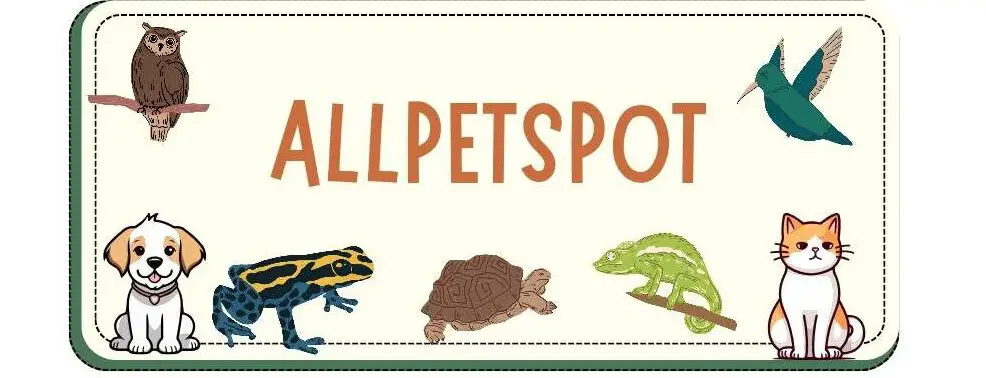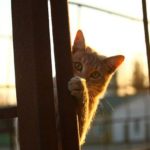Ragdoll color progression is absolutely fascinating and impressive to observe. Ragdolls come in outstanding coat colors and patterns, but irrespective of whichever color or pattern your ragdoll come in, the most fascinating thing is the noticeable color change over time.
Ragdoll color progression is greatly affected by two factors, body temperature, and age.
You can see your ragdoll color change so fast, mostly due to the sharp change in body temperature.
Now let’s talk about the ragdoll color progression, but before then let’s first run through the fundamentals of ragdoll colors.
Recommended; Ragdoll Characteristics, Information, Health, Personality & All You Need To Know
Ragdoll Colors
Here are all the possible colors that a ragdoll cat can come in, most ragdoll cats might come in a combination of the listed colors
- Seal
- Blue
- Cream
- Chocolate
- Lilac
- Mink
- Tortie
- lynx
- Solid
- Flame
- Red
Here are the basic three levels of ragdoll colors that apply to all ragdoll, which are the common, rare, and more rare colors, and breeders take very good note of these color levels. Let’s roll
Checkout; Can Ragdoll Cats Be Left Alone
What are the Common Ragdoll Colors
The most common ragdoll colors you can easily get around from most breeders are the seal and blue color, these come in a price range of $800 to $2000 in the United States depending on the breeder’s price tag.
Recommended post: How To Take Care Of A Ragdoll Cat: 18 Basic Ways To Care For Ragdolls.
What are the Rare Ragdoll Colors
The rare ragdoll colors are flame, lynx, and tortie.
However, these colors are very important for breeding purposes, and breeders keep a close tab on them because they possess a rare set of genes that gives these remarkable colors.
Ragdolls in these colors cost around $900 to $2500, depending on the breeder.
What are the More Rare Ragdoll Colors
Even as popular as ragdolls are there are still more rare colors to find, the more rare ragdoll colors are chocolate, lilac, cream, cinnamon, and fawn.
Sometimes these colors are hard to find and even when you find them they come in a high price range of about $1000 to $2500 breeders price tag applies.
Recommended: Why Cats Run Away From Their Owners – 7 Best Reasons
What is the Most Popular Ragdoll Color
The most popular ragdoll color is the seal point which you call almost find with every breeder around you.
The seal point is the symbol of a ragdoll cat, when ever you think of a ragdoll or search for a ragdoll cat the seal point is normally the color that will pop up.
Now we are through with the fundamentals of a ragdoll color, let’s get into the color progression which is generally affected by body temperature and age.
The Chemistry of Ragdoll Color Progression
All brightly colored cat breeds have a specially modified gene that changes the color gene. This blocks the pigment, thereby causing albinism.
However, this modification signal only penetrates the cat’s coat if it is above a certain temperature.
The converter in the ragdoll body starts to send a signal at 38-39.2° C, which is the cat’s standard body temperature, with the message “Stop color”.
Anything lower than that and the mutation gets blocked and the color gene can then take on its own color; Since a cat’s body is cooler around the ears, feet, and tail, this is where the color starts.
The uterus is quite warm, so all kittens with this particular allele modifier will be white during pregnancy.
They are also born white kittens, but upon exposure to the atmosphere, their limbs start to cool.
Once they reach this critical temperature, alleles that block the enzymes responsible for pigments are turned off and their color begins to develop – in the ears, feet, tail, and face.
All you need to turn this cat into an albino is to raise its body temperature.
That is why the color is brighter in summer than in winter because the coat color becomes lighter, from a high body temperature and darkening from a lower temperature.
The bandages or cat clothes that cover the hair can change color, and after shaving the hair that grows back is often darker in color because this body part is cooler than the rest of the body but flattens out after a while when body temperature is reached it changes back to the same color as the other parts of the trunk of the human body.
See more; What Health Problems do Ragdoll Cats Have – Symptoms & Possible Solutions
Ragdoll Color Progression
Here is the few selected ragdoll cat color progression. They are a few points to take away, which I would like to point out before we continue: all ragdolls are born white, all color change or progression is triggered by two basic things, age and temperature, that been said let’s move on.
Seal Colorpoint color progression
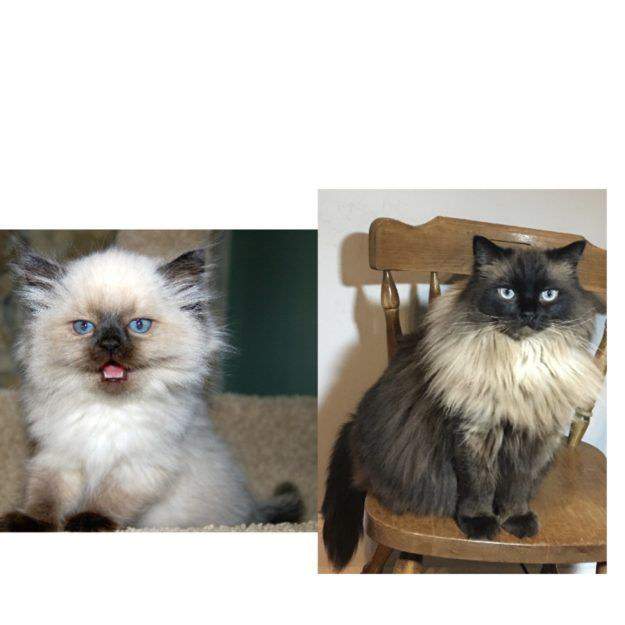
Ragdoll color progression Seal point is one of the popular and well-pronounced color progressions in ragdoll.
As you can see from the image above, ragdolls change color with age.
At the kitten stages, all ragdoll appear white but as time progresses they gradually assume a definite color that is produced genetically.
A close look at the image above will simply tell you that the change in the seal point color is directly proportional to the age of the cat, that is to stay that as the ragdoll kitten grows older the seal point color extends to the other parts of the body and becomes more visible and darker.
At 2 to 12 weeks you will notice the darkening of the fore face of the kitten which is very clear, and as the kitten grows older this darkening will keep extending to other parts of the body.
Read more; Ragdoll Cat behavior problems – 9 Common Behavior
Seal Mink color progression
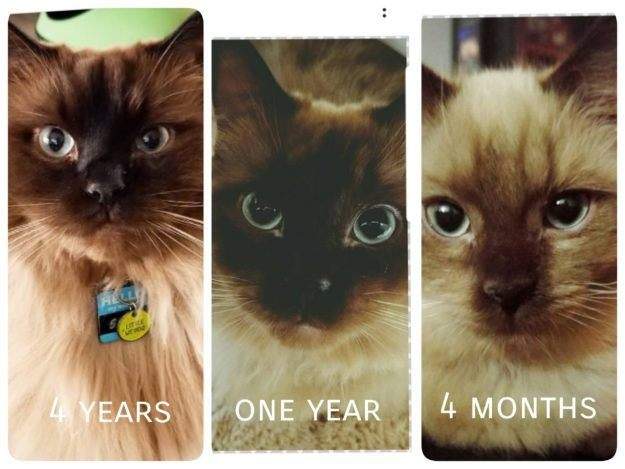
The Seal mink Ragdoll color progression is very pronounced, this is to say that the color intensity of the seal mink ragdoll is directly proportional to the growth rate, in simpler terms as the cat grows older the seal mink color appear to be more intense.
This is a clear indication of ragdoll color progression.
Seal Mitted color progression
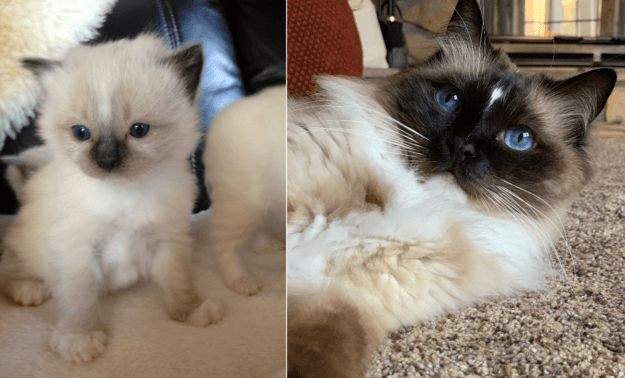
The Ragdoll color progression Seal mitted is not as pronounced as that of the seal point.
However, they have the same trend when you view it from the darkening of the fore face point of view.
A close look at the seal mitted ragdoll you will observe that the bold white line that runs in between the forehead vanishes with time as the cat grows older.
Even as this bold white color vanishes with time, the mark is still there. While the face becomes darker with time, you can still find a few touches of the seal point color over the eyelids.
Read more; Why Male Cats Run Away From Owners – 6 Top Reasons & Solutions
Seal Bicolor color progression
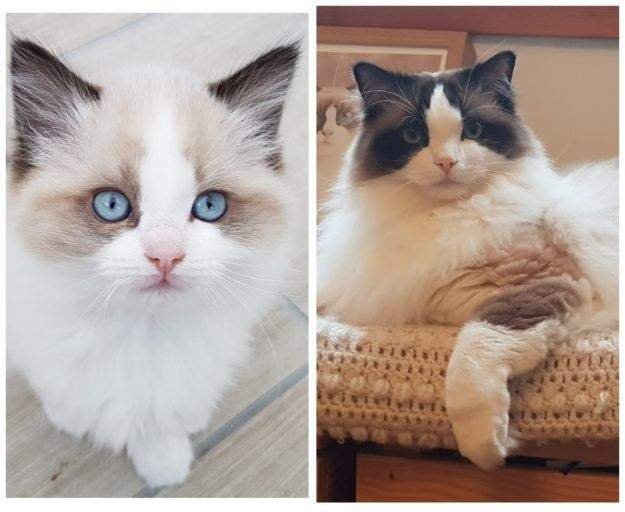
There is a significant color progression with the Seal Bicolor ragdoll cat. The intensity of the Seal Bicolor that runs from the neck through the ears down to the chicks increases with growth.
However, the white bold line that runs from the forehead down to the lower jaw remained the same or constant with growth.
Seal lynx color progression
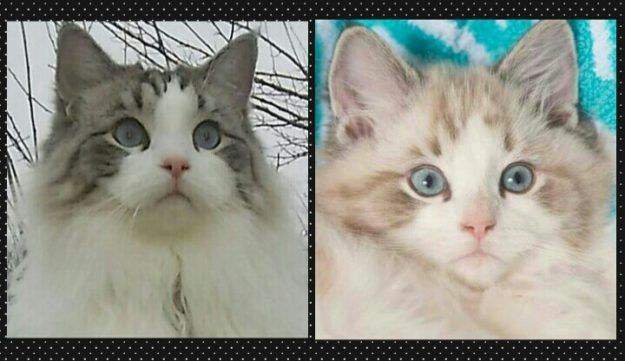
There is no significant color progression with the Seal Lynx ragdoll except for the increase in the intensity of the triangular Seal Lynx color that runs from the neck through the forehead down to the chicks.
Have you seen; Why Female Cats Run Away From Home – 7 Ultimate Reasons
Blue Colorpoint color progression
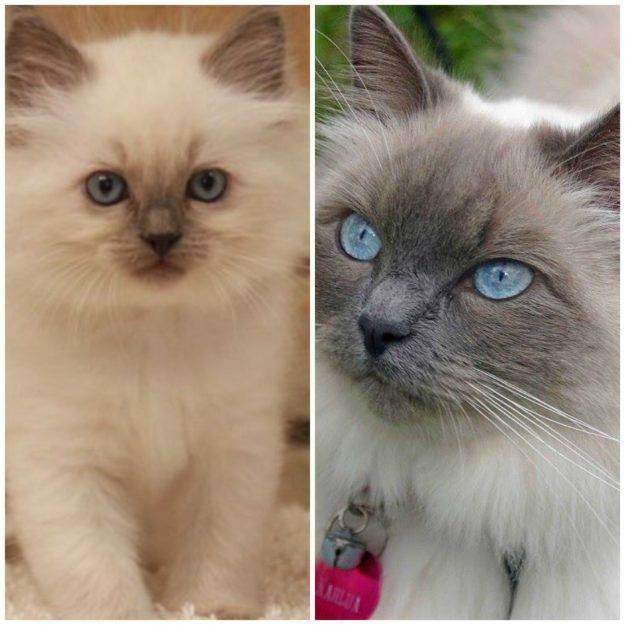
The major color progression with the blue color point ragdoll is that the intensity of the blue color point at the face increased with growth, and extended down to the whole face of the ragdoll over time.
Blue Mitted color progression

The blue mitted color ragdoll has no significant color progression. However, the intensity of the blue mitted color increased with growth but was not significant.
Another noticeable mark is that the bold white line that runs through from the forehead down to the nose remained the same with growth.
Checkout; Why Are Cats Attracted To My house? – 7 Top Reasons
Blue Bicolor color progression
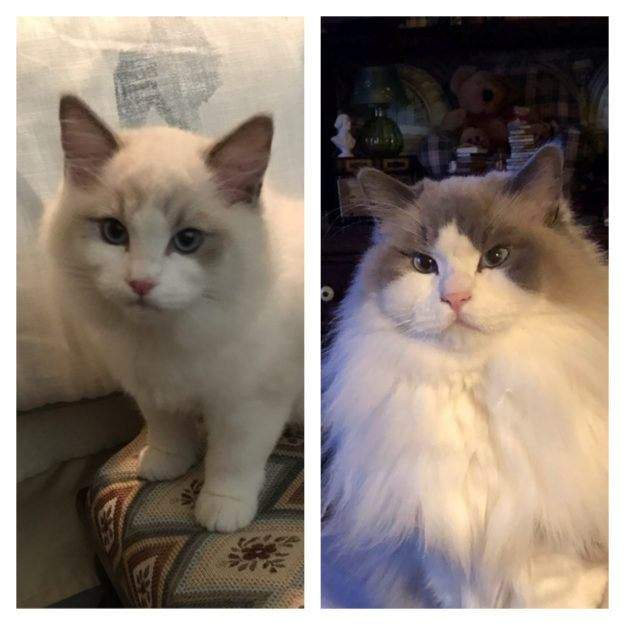
A very noticeable change with the Blue Bicolor ragdoll cat is that the intensity of the Blue Bicolor at the head of the ragdoll increased over time.
There is this triangular line or mark that runs down from the forehead through the eye down to the chicks, at the kitten stage this triangular line was faint but as the cat grows older the line becomes more intense and visible.
Blue lynx color progression
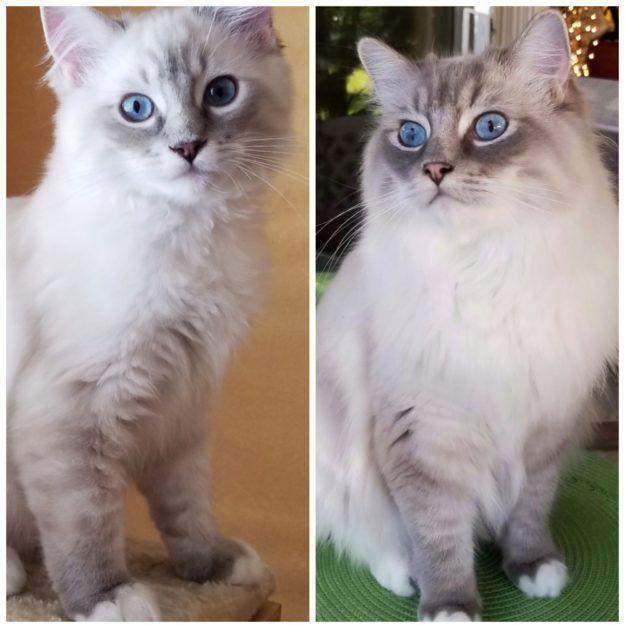
The only noticeable color progression with the Blue Lynx is just that the intensity of the Blue Lynx color at the head increase with the age of the cat.
Must see; Why Lost Cats Never Return Home Again – 9 Possible Scenarios
Flame color progression
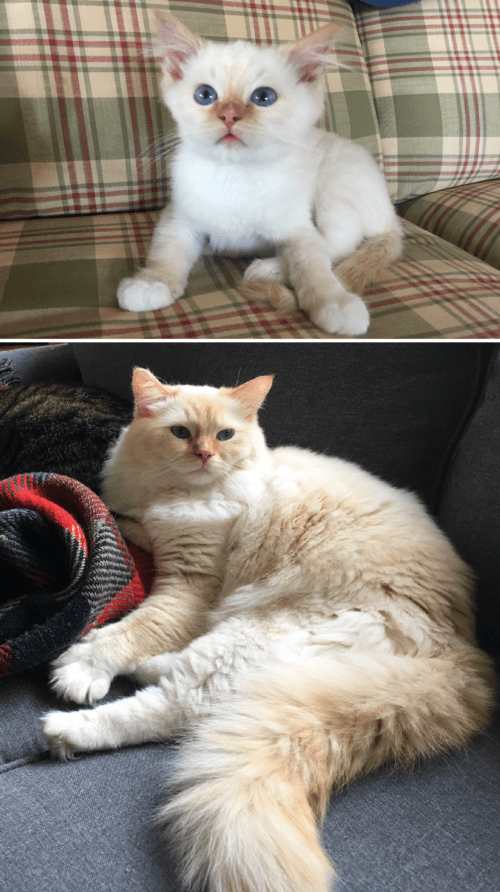
The Flame Color progression is very clear and understandable because the intensity of all the flame color touches all over the flame color ragdoll increases with time especially the flame color on the head.
You can also notice that as the flame color ragdoll grows older the intensity of the flame color at the tail vanishes with time.
Mink mitted color progression
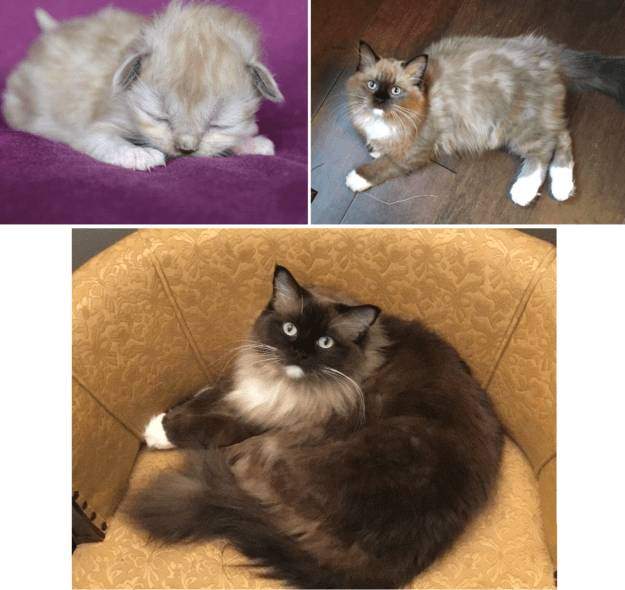
The Mink Mitted color progression is very self-explanatory because the intensity of the mink mitted color is a function or is dependent on the growth.
However, there is still a part of the mink mitted ragdoll that remains the same even as growth progresses. Which is the white region below the jaw of any mink mitted rogdoll.
Recommended; 10 Best Things to do to Find a Lost cat
Cheers!!!
